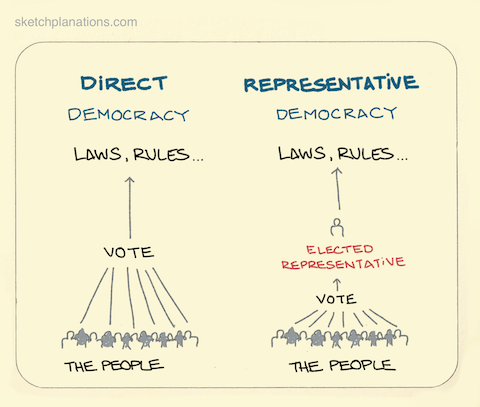
Is Representative Government Truly Representative
A case study of Australia
Let’s just imagine for a minute that you could wake up one day in a civilization that was devoid of any political structure and you could start from afresh. How would you choose for this society to run or be run politically? Here is the opportunity to implement a system of rule that is the best and optimal for the society to flourish in peace and grow. History has given us numerous different types of government to decide from already. Some have been more successful than others. Some have given power to the many and others to an individual. At a high level, the different types of government available are democracy, monarchy, autocracy, theocracy and oligarchy. Within each of these are subgroups also available. Alternatively, you could choose anarchism and let nobody, or group have a ruling authority.
Assuming that you have no desires for despotic leadership and instead want a system that allows all citizens to have a say, you are most likely to look to democracy as the best fit. Despite the plethora of different types of democracy available, the two common ones are representative and direct. Direct can work for a small population size as it gives every individual the opportunity to vote directly on policies without an intermediary. Representative democracy is more workable in larger population as the population chose representatives to act on their behalf. Although the term democracy is derived from the Greek language, demos, “common people” and kratos, “strength”. However, representative democracy is more widely recognized as having its origins in the Roman Republic. Fast forward to present day and we arrive at a system of government that exists in most westernized countries. Does this mean it is the best form of government? Like most things, beauty is in the eye of the beholder. Given the freedoms that are enjoyed under this system and how much civil liberties and political rights are measured, it is probably the best system for our new community.
So, you settle on a representative system of government as the best way forward. The next step will be to elect intermediaries that are a fair representation of the population. How can this be done? Are these intermediaries elected from certain social strata’s, demographic categories or geographic area? A you can see, there are challenges and limitations with all three of the above. However, in order to get a reasonable cross section of population in regards to age, education, income and any other variables, you decide to split the population in to geographic zones. Each zone will then have one representative elected to represent the population in that given area.
So, looking back at what you have done. You have decided on a government that is a representative democracy as this is the best method to manage the process for the population size. Your country has been split in to areas that give a cross sectional representation of the population to allow for age, demographics and other variables that exist. Job done? In one sense yes. But what is of interest in this exercise is just how representative of the population are these elected representatives that will go in to be the voice of the people that allows your democracy to function true to the term demos, the common people.
Let’s mow turn our fictitious country in to a real-world example. 1901 saw the federation of Australia and the establishment of its own parliament. The democratic model adopted was in line with that of the United Kingdoms, given that Australia was part of the British Commonwealth, this seems fair and reasonable. Australia, at the time, was made up of states and territories of varying population sizes. These states and territories also adopted a self-governing representative democracy to deal with regional issues and matters. For the purpose of this example though, I will only be looking at the national, or federal, government. It is fair to say though, that the assumptions made that pertain to the Federal Government also apply at a state and territory level. The total population of the nation at Federation was approximately 3.7 million.
If we fast forward to present times, Australia’s population has grown to 25 million and we mow live in a world saturated with news and information available to the population, regardless of their location in this huge country. The population is made up of a multitude of new and varied occupations that never existed 100 years ago. Add to this the shift in the demographics of the workforce that has seen a fair greater representation of females taking up vital roles in the economy. The question that arises then, does our form of representative democracy still reflect the population it represents?
It must be pointed out that from the onset the Australian Government was not representative of the population in regard to gender. Australia’s first female politician, Edith Cowan, was not elected until 1921. This could be viewed as a first strike against a true representative democracy and may also be reflective of the broader status of women in general around the world at the time. However, was relatively progressive in that women were granted voting rights in 1902. You can assume then that there were other machinations going on that resulted in no female parliamentarians until Cowan. Another missing, or unrepresented, group of the population was that of Indigenous Australians. It was not until 1972 that Neville Bonner become the country’s first Aboriginal Federal Senator. The 1971 census count had a population total of 115,953 Aboriginals in Australia. This number is most likely vastly underestimated due to the lack of accurate counting and access to available population.
It only takes a minimal amount of scrolling through the MP’s and Senators in the Australian Government to notice how many have a legal background. This can make sense as law is made in parliament and is a process dating back several centuries. Therefore, it may appear reasonable that lawyers are interested in developing and passing laws. There is also a level of human rights and social justice that forms part of the legal framework and once again, this may attract law professionals to be interested in developing policies in these areas. However, even if 30% of our elected representatives have a legal background, this is far in excess of the ratio of legal professionals in the general adult voting population. Does a legal professional understand the challenges of someone in state housing that has limited education and receiving unemployment benefits? Probably not.
From the outside then, we can assume that those elected to represent the best interests of the population at large are not truly representative of this group. Gender representation has improved since Federation but there are more groups in Australia that are probably under represented. As we become more diverse culturally, we should see more cultural diversity in our Parliament. Unfortunately, a cursory view of those running the country demonstrates we still have a very white European look to our elected representatives.
This is not the fault though of the hard-working individuals that aspire to serve in Parliament in an effort to improve the country as a whole. The problem may not even be systemic of the process of elections, political parties, nominations and government. It may just be there is a lack of interest in the majority of the population to be thrust in to the public spotlight or even an overall apathy in how the parliamentary process works. I am sure there is ample academic discussion on the subject, as well as countless dinner table conversations on the reasons.
Returning to our original question then, what system of government would work best for our newly created state. Representative democracy with its many flaws when it comes to truly representing a population, is possibly still the best fit. Despite the level of skewing towards legal professionals, there are no real barriers to any member of the population attempting to become an elected representative. Yes, there is still a way to go until we look at our Government and see our society reflected at us, but this will take time.
